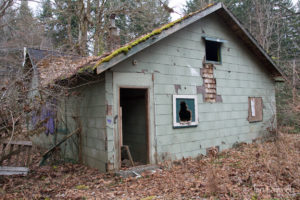PROTECTION OF TOWNSEND’S BIG-EARED BAT COLONY
 NTLCBC is working with the Province of British Columbia and other partners to protect a rare maternity (nursing) colony of Townsend’s Big-eared Bats, located in the Qualicum area of Vancouver Island. The population of this threatened species (Corynorhinus townsendii, also known as the Lump-nosed Bat or Western Big-eared Bat) is collapsing all across western North America, and is currently blue-listed in BC. Only a handful of maternity colonies have been documented in BC, and this site is one of only three known colonies on Vancouver Island (the others being in the Comox and Duncan areas).
NTLCBC is working with the Province of British Columbia and other partners to protect a rare maternity (nursing) colony of Townsend’s Big-eared Bats, located in the Qualicum area of Vancouver Island. The population of this threatened species (Corynorhinus townsendii, also known as the Lump-nosed Bat or Western Big-eared Bat) is collapsing all across western North America, and is currently blue-listed in BC. Only a handful of maternity colonies have been documented in BC, and this site is one of only three known colonies on Vancouver Island (the others being in the Comox and Duncan areas).
Conservation History of the Site

Existing derelict house containing the bat colony. Entrance is the square opening to the attic.
The site was first identified as being in need of protection in 1999. A nursing colony of Townsend’s Big-eared Bats had been confirmed to be using a derelict house on this residential property in the Qualicum area of central Vancouver Island. The property had been listed for sale, and such a sale would have resulted in the immediate demolition of the derelict house and, ultimately, the loss of the critical nursing habitat. The imminent threat was brought to the attention of Bill Turner (NTLCBC Chairperson) who was, at that time, working with The Land Conservancy of BC (TLC). Due to the urgent need for protection of the site, Turner mobilized TLC, within a few days, to arrange for the acquisition (purchase, with a mortgage) of the property, in order to secure its future.
The site remained under TLC’s care for the next 20 years (approx), and the mortgage was substantively paid down. It was monitored regularly to ensure the well-being and ongoing health of the colony, as well as the structural condition of the derelict structure that housed the colony. It was always anticipated that, at some point, the structure would collapse and have to be replaced, but no substantive changes had to be made to the property under TLC’s stewardship.
However, when The Land Conservancy ran into financial difficulties in 2015 (approx) the future of the property was again put in jeopardy. The TLC Board decided to change its focus and reduce its conservation objectives, restructuring the organization and transferring most of its property holdings and protected areas to other land trusts. (By that time, Turner and other senior TLC staff had departed, and were involved in setting up NTLCBC as a new land trust). Most of TLC’s property transfers were completed by 2017, but this particular property was not transferred. It was instead given, in lieu of debts owed, to a private BC-based mortgage company (0793468 BC Ltd.) which had loaned funds to help TLC’s operations.
This put the bat habitat at risk once again. In order for the mortgage company to recover the funds it had loaned to TLC, it would be necessary for them to sell the property, and in order to sell the property it would be necessary for the derelict house to be removed (in order to provide the opportunity for the site to be rebuilt and occupied as residential property). Fortunately all seven of the investors in the mortgage company were also conservationists (some of them former staff of TLC) and they were all concerned about the future protection of the bats. So instead of just selling the property, they decided to delay recovery of their funds and instead began discussions with NTLCBC to see if more innovative solutions could be found.
NTLCBC took on the task and, in 2018, began working with the mortgage company, other partners and with staff biologists at the Provincial Ministry of Environment and Climate Change Strategy, who are responsible for management of threatened species. A strategy was developed which, although innovative and never tried before, held significant potential to continue the protection of the bat colony while also allowing the mortgage company to recover its funds. The strategy involved relocating the bat colony to a new, purpose-built facility located in a corner of the property, severing that small portion of the property and transferring it to NTLCBC to ensure its ongoing protection. This would leave the remainder of the property available for sale.
The summer of 2021 was the critical time to determine if the conservation strategy would be successful, and we are delighted to announce that it appears to be meeting everyone’s hopes and expectations. It will require two or three more years to be fully assured of the long-term success of the strategy, and we are enthusiastically awaiting the results. Stay tuned.
For more details about the conservation strategy, and steps taken by NTLCBC to protect the bat colony, please click here.




